In recent years, and for reasons never explained, Honda supplied its MotoGP team with "softer" engines that were short of acceleration and top speed. This forced users to seek lap time where they could, in radically late and hard braking. That riding style had the effect of forcing the Honda men to use the hardest front tires, further compromising their riding.
This year, with power restored, Márquez has taken to starting first and staying first, all the way to the end. On Sunday at Le Mans, with the exception of a bold challenge from Pramac Ducati's Jack Miller, who passed Márquez and back and forthed with him for two or more laps—Miller led laps 5 and 6—Márquez eased away to win the 27-lap French Grand Prix by a managed 1.984 seconds from Andrea Dovizioso. Danilo Petrucci, Dovizioso's factory Ducati teammate, was third, followed by Miller and top Yamaha finisher Valentino Rossi.
Are you bored by this one-rider winning streak? Do you perhaps resent and even blame Márquez for it? Mick Doohan, winner of five straight 500cc Grand Prix titles, said of this situation, it's not up to the leader to slow down, but for his pursuers to improve. Márquez makes what he's doing look easy, but it's not easy.
The 26-year-old Spaniard spoke of the change in his riding style made possible by this year’s stronger Honda engines: “Last year, we just tried to find the lap time on the brake point. This year maybe we lose a little on the brake point but we gain in other areas. This is the right way because always the brake point means risk. And risk means it’s difficult to be [consistent].”
He described the old way: “If you brake late and you go in with too much speed, you overheat [the front tire]. And if you follow other riders [drafting], you overheat the front. For that reason, today I tried to lead the race from the beginning, find fresh air, and ride smooth."
Easier said than done, for the faster a rider goes, the sooner comes tire deterioration. Once Miller had got past Petrucci, he said, “I just reeled in Marc, then got past Marc, and I probably spent too much of the [tires’] edge trying to do so.”
Miller’s pace faded after he took the lead, but Márquez had more in hand. “I just couldn’t run his pace,” Miller said. “It seemed he was getting quicker and quicker, lap by lap.” Miller’s board was reporting that Márquez was drawing away by tenths, and the Australian was noticing that Márquez was deliberately saving his tires’ edges by coming off certain turns “just off the edge.”
So much for the idea of just goin’ for it. Márquez had to take a moment to fend off Miller’s all-or-nothing attack, but edge was off Miller’s ride. Rossi worked to gain on Miller but couldn’t overtake.
Dovizioso, who came through to finish second, said, “What we have is not enough against Márquez and the Honda. “I have no special cards that allow me to play against Marc. He’s making the difference in too many races.”
Another notion favored by those who want a different rider to win is, “It’s the bike. If my guy had his bike, he’d be winning.” Crutchlow has Márquez’s bike. Takaaki Nakagami and Jorge Lorenzo have Marquez’s bike. Crutchlow rides the occasional really strong race, for which he deserves great praise, but he is not consistent. The very bike that Márquez finds “rounder” in its performance strikes Crutchlow very differently. “The front end and front feeling for me is way more critical than last year,” he said. “A lot of this stems from the engine [braking]. The bike is so unstable entering the corner.”
This sounds like it could be the “technical problem” blamed for Márquez’s fall while leading the race at Circuit of The Americas, now said to have been fixed.
Once again, the conclusion is that the best bike-and-rider combinations are intimately mutually adapted. They are not paper dolls to be mixed and matched. Just ask Johann Zarco or Lorenzo, who have yet to adapt to their respective 2019 rides, KTM and Honda. Yes, the Yamaha is the easiest bike, many can ride it, but it no longer wins races, despite the brilliance of the low-hours men, Franco Morbidelli and Fabio Quartararo, who were seventh and eighth in the race. Quartararo had topped Free Practice 1 on Friday and Warm Up on Sunday.
Rossi put it this way, while discussing the problems of the Yamaha M1: “Marc is the biggest problem of all. He is the fastest on every track and in every condition.”
Mixed conditions in Saturday’s qualifying dealt Rossi’s teammate Maverick Viñales a start from 11th position, despite his having in versatile fashion topped both the dry FP2 and wet FP3. A collision with Miller’s teammate, Francesco Bagnaia, during the race ended Viñales’ day.
For some time now, I’ve suspected that the effectiveness of the corner-speed riding style is falling behind the variations of point and shoot displayed by Márquez and the top Ducati men. If this is true, Yamaha may not return to competitiveness without a major rethink.
Márquez noted this weekend that the Yamahas go well when grip is good. When grip is not so good, the Yamahas can't accelerate and can't brake because, being built long and low, they transfer less weight to the tire doing the work than do the bikes specialized for point and shoot. If grip is good, they can work, but if it's not so good, they're nowhere. Freddie Spencer was able to win the 1983 500cc championship with corner speed but only because his more powerful competition was devouring its tires trying to keep up with his underpowered Honda. That's no longer the case. Tires, if anything, now last better on point and shooters because they spend less time down on the edges of the tires, and Márquez adds his own sophistication to that.
Another point: Bridgestones had very stiff carcasses, which gave corner-speed riders what they need: tires that don’t buckle under continuous heavy turning load. Today’s Michelins, by contrast, have softer carcasses that spread out the generous footprint that point and shootists need for recovering speed during hard acceleration away from their slow apexes.
Petrucci was candid about his third-place finish: “At the beginning, I was there with Marc and for sure he was controlling the race. I didn’t want to let him go, but I made a big mistake in turn 8 and lost three positions.”
The Ducatis are improved this year, but the Hondas and Márquez have together improved more. The Yamahas are improved as well, Rossi noted. “It looks like in the last laps this year we have less problem compared to last year.” But also, “I wasn’t fast enough. I lost too much on the straight. I lost too much in acceleration in the low-speed corners.”
Two fascinating developments command our attention. First is Quartararo, who started 10th and ran off early, losing more positions. During his climb back to finish eighth, he did not burn up his tire in pursuit, but gained speed through the race, lapping faster than the leader and setting fastest race time on lap 20. This is adult tire management. Everyone will be after this young man, waving contracts.
The other development is Pol Espargaró, putting the “can’t possibly work” KTM—steel frame, WP suspension—in sixth. Yes, we are sorry to see Zarco’s proven skills at odds with his KTM’s conflicting style, but sixth is serious progress.
Although Sunday could have brought more dreary rain, the actual weather was cooler, forcing all riders onto the one slick-tire combination that could be brought to temperature—soft front and soft rear—save for Nakagami’s medium front.
After the race, Quartararo said, “I’ve learned a lot about tire management today and I can’t wait to get to Mugello and put into practice what I have learned.”











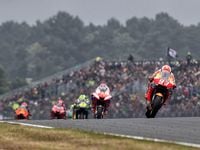
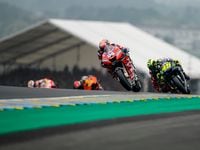
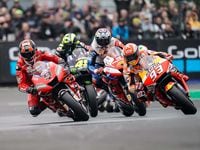
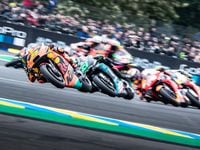
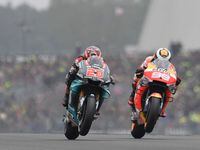
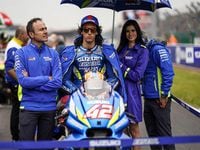
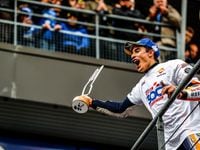
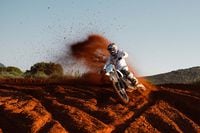
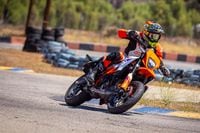
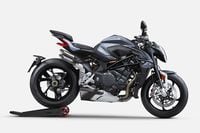
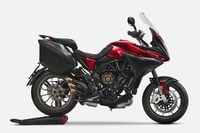
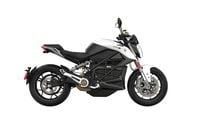
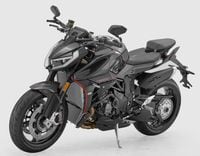




/cloudfront-us-east-1.images.arcpublishing.com/octane/URQMNYZZ6ZBM5LXGREBV3Y72OM.jpg)
/cloudfront-us-east-1.images.arcpublishing.com/octane/XH2ETEU4NVGDFNQO2XT2QQS5LU.jpg)
/cloudfront-us-east-1.images.arcpublishing.com/octane/DUGAQC2GQJCXFILEECQK2Q6T7I.jpg)
/cloudfront-us-east-1.images.arcpublishing.com/octane/4OGCCVR7WZGYDOWK4CGDTHXITA.jpg)
/cloudfront-us-east-1.images.arcpublishing.com/octane/GQV7Y6XT6FGZDIXO4P2IVJNSYE.jpg)
/cloudfront-us-east-1.images.arcpublishing.com/octane/X47GL62AXNALRHQLLBELY5WRMY.jpg)
/cloudfront-us-east-1.images.arcpublishing.com/octane/7OY2GP3FWFEDVEMDSLNGM6PZRM.jpg)
/cloudfront-us-east-1.images.arcpublishing.com/octane/Y3XYCFONBBBAHN6BWJDTWDY3FE.jpg)
/cloudfront-us-east-1.images.arcpublishing.com/octane/P3DLTISFGJA43L5QXVH7365UNY.jpg)
/cloudfront-us-east-1.images.arcpublishing.com/octane/H6FFG4YQMREO3DTADIJMECNS7Y.jpg)
/cloudfront-us-east-1.images.arcpublishing.com/octane/QCUUDRRAIFHDDGB5OTZVKUS554.jpg)
/cloudfront-us-east-1.images.arcpublishing.com/octane/RBDRR2OHFFBPRNXW6V3FN2SNAM.jpg)
/cloudfront-us-east-1.images.arcpublishing.com/octane/EFFSPCZVBBCMTNGVEQMB7NNKIU.jpg)
/cloudfront-us-east-1.images.arcpublishing.com/octane/5GP3PUGFKVGUVCEYG4ZBDYLNBE.jpg)